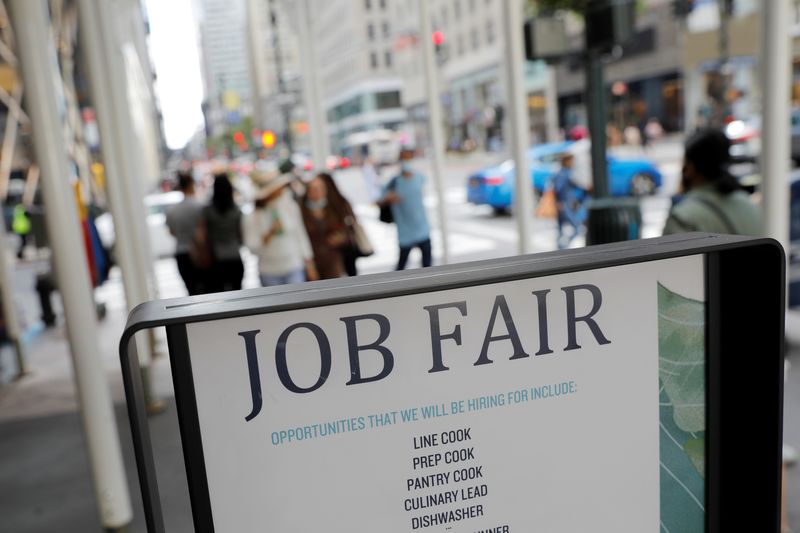By Lucia Mutikani
WASHINGTON (Reuters) -The number of Americans filing new applications for unemployment benefits rose marginally last week, suggesting no deterioration in labor market conditions and reinforcing expectations that the Federal Reserve would not cut interest rates next week.
Though layoffs are still low, new opportunities for workers who lose their jobs are dwindling as employers remain cautious about increasing headcount. The report from the Labor Department on Thursday showed jobless rolls swelling to the highest level in just over three years in early January.
"The labor market is historically tight but some sectors are slowing the pace of hirings," said Jeffrey Roach, chief economist at LPL Financial (NASDAQ:LPLA). "The data suggest minimal stress in job markets. As long as wage growth outpaces the rate of inflation, the economy will chug along, and the Fed will not cut rates as much as expected only a few months ago."
Initial claims for state unemployment benefits increased 6,000 to a seasonally adjusted 223,000 for the week ended Jan. 18. Economists polled by Reuters had forecast 220,000 claims for the latest week. Claims were likely lifted by the wildfire in Los Angeles, with unadjusted applications increasing in California, but falling in the majority of states.
Freezing temperatures that have gripped large parts of the country as a well as blizzards in the South could temporarily boost claims in the weeks ahead. But through the distortions, the labor market will likely continue chugging along, keeping the economic expansion on track.
"The impact of the California wildfires may have exerted a mild upward impetus on the latest reading," said Stephen Stanley, chief U.S. economist at Santander (BME:SAN) U.S. Capital Markets. "More fallout from that situation seems likely going forward, and the historic snowstorm in the South this week also will probably boost the tally for the current week."
Unadjusted claims plunged 68,135 to 284,222 last week as a 6,744 jump in filings in California was more than offset by a 9,025 drop in Michigan. Applications in Michigan had surged by 14,985 in the prior week, blamed on layoffs in manufacturing.
Big declines in unadjusted claims were also reported in Texas, Ohio, Georgia, New York, Missouri, Illinois, Pennsylvania, South Carolina, Kentucky, Iowa and Connecticut.
The dollar was little changed against a basket of currencies. U.S. Treasury yields rose.
FED ON HOLD NEXT WEEK
Labor market sturdiness was among factors that prompted the U.S. central bank last month to dial back its projected interest rate cuts for this year to only two from the four it estimated in September when it launched its policy easing cycle.
An immigration crackdown by President Donald Trump's new administration as well as plans for tax cuts and broad tariffs, which economists have warned are inflationary, also added to caution among Fed officials on the course of monetary policy. Mass deportations and restrictions to legal immigration could hamper the labor market, economists said.
No rate cut is expected at the central bank's policy meeting next week. The Fed has cut its benchmark overnight interest rate by 100 basis points to the current 4.25%-4.50% range since September. The policy rate was hiked by 5.25 percentage points in 2022 and 2023.
Last week's claims data covered the period during which the government surveyed businesses for the nonfarm payrolls component of January's employment report. Claims rose slightly between the December and January survey weeks
Nonfarm payrolls increased by 256,000 jobs in December. The economy added 2.2 million jobs last year, averaging 186,000 positions per month, down from 3.0 million in 2023.
Data next week on the number of people receiving benefits after an initial week of aid, a proxy for hiring, could offer more clues on the health of the labor market in January.

The so-called continuing claims rose 46,000 to a seasonally adjusted 1.899 million during the week ending Jan. 11, the highest level since mid-November 2021, the claims report showed.
"The level of continued claims, despite low layoffs, is consistent with other labor market metrics, such as a low pace of hiring, and shows that it is somewhat difficult for those who do lose their jobs to find new work," said Nancy Vanden Houten, lead U.S. economist at Oxford Economics.